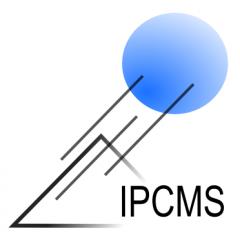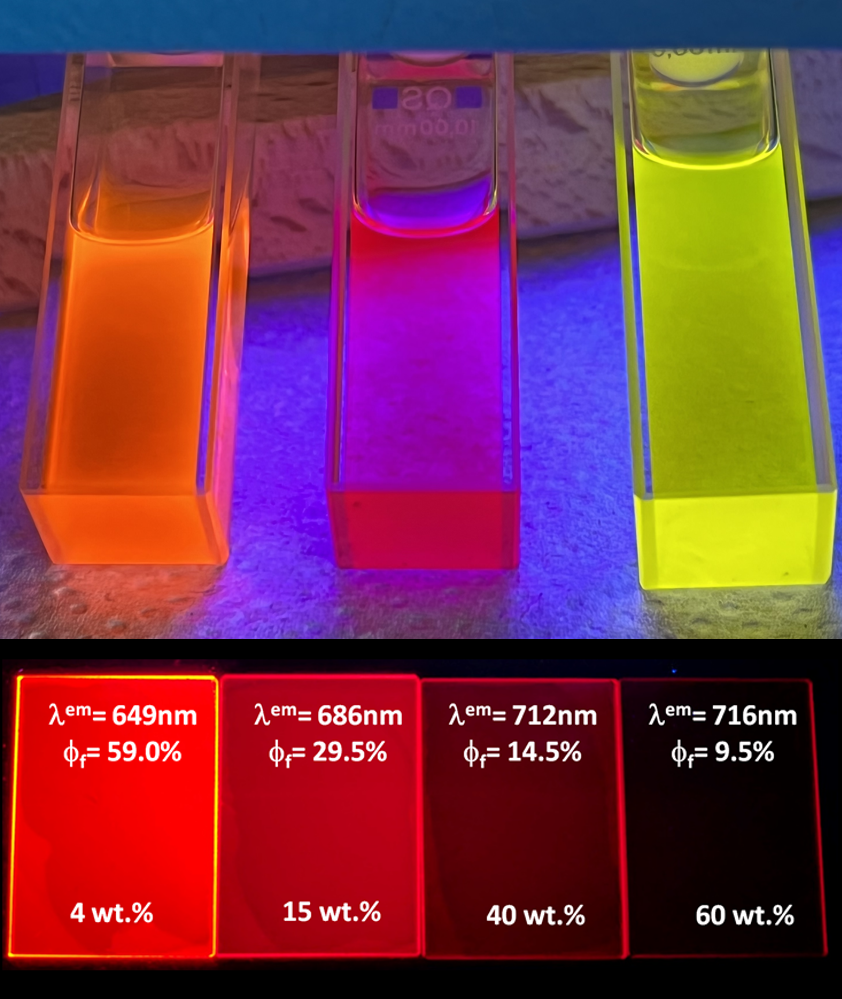Luminescent materials are of great importance for many applications spanning from bio-imaging to organic electronics.
We are currently designing, synthesizing and studying fluorescent materials that are further implemented for two-photon bio-imaging and in devices through collaborations. The design of the dyes is done considering the targeted applications resulting in high performance properties.
Therefore, research to optimize and rationalize the photophysical properties can be described by the following topics :
a
1. Design, synthesis and understanding of solid-state emitters
Donor-Acceptor and Donor-Acceptor-Donor boron difluoride complexes can be designed in order to emit in their solid state form (as powder or as their nanoparticles state). Design of the electron donor and electron acceptor moiety permit to access emitters with fluorescence quantum yield reaching almost 20% above 720nm and 15% at 755nm. Those properties could be obtained by using the dipolar and quadrupolar properties of 2’-hydroxychalcone and curcuminoid boron difluoride.

blanc
Ref.
- A. D’Aléo, D. Gachet, V. Heresanu, M. Giorgi, F. Fages Chem. Eur. J. 2012, 18(40), 12764-12772. Efficient NIR Light Emission in Solid-State Borondifluoride Complexes of 2’-Hydroxychalcone Derivatives.
- A. D’Aléo, A. Felouat, V. Heresanu, A. Ranguis, D. Chaudanson, A. Karapetyan, M. Giorgi, F. Fages J. Mater. Chem. C 2014, 2, 5208-5215. Two-Photon Excited Fluorescence of BF2 Complexes of Curcumin Analogues: Toward NIR-to-NIR Fluorescent Organic Nanoparticles.
- A. D’Aléo, V. Heresanu, M. Giorgi, B. Le Guennic, D. Jacquemin, F. Fages J. Phys. Chem. C 2014, 118, 11906-11918, NIR Emission in Borondifluoride Complexes of 2’-Hydroxychalcone Derivatives Containing an Acetonaphthone Ring.
blanc
2. Development of NIR-to-NIR emitters
To efficiently bio-image cells, in-depth penetration fluorescent measurements needs to be done. To do so, Near-Infra-Red (NIR) region (from 700nm to 1300nm) is a region of interest. Therefore, NIR-to-NIR dyes, where excitation and detection are performed in this region of the spectrum, are targeted. To reach such excitation in the NIR, Two-Photon Induced Fluorescence (TPIF) technique represents one of the most efficient way to do so.
In this application, we are seeking for dyes that can also efficiently emit in the NIR region and showing high two-photon cross section in the region spanning from 350-650nm. The latter properties can be obtained by using strong charge transfer excited state as illustrated in the examples below. Following this strategy, we succeeded to obtain dyes with two-photon cross section around 4000-6000 GM.

blanc
Ref.
- A. D’Aléo, A. Felouat, V. Heresanu, A. Ranguis, D. Chaudanson, A. Karapetyan, M. Giorgi, F. Fages J. Mater. Chem. C 2014, 2, 5208-5215. Two-Photon Excited Fluorescence of BF2 Complexes of Curcumin Analogues: Toward NIR-to-NIR Fluorescent Organic Nanoparticles.
- E. Kim, A. Felouat, E. Zaborova, J.-C. Ribierre, J. W. Wu, S. Senatore, C. Matthews, P.-F. Lenne, C. Baffert, A. Karapetyan, M. Giorgi, D. Jacquemin, M. Ponce-Vargas, B. Le Guennic, F. Fages, A. D’Aléo Org. Biomol. Chem. 2016, 14; 1311-1324.Borondifluoride complexes of hemicurcuminoids as bio-inspired push-pull dyes for bioimaging.
- K. Kamada, T. Namikawa, S. Senatore, C. Matthews, P.-F. Lenne, O. Maury, C. Andraud, M. Ponce-Vargas, B. Le Guennic, D. Jacquemin, P. Agbo, D. D. An, S. S. Gauny, X. Liu, R. J. Abergel, F. Fages, A. D’Aléo Chem. Eur. J. 2016, 22(15), 5219–5232. Two-photon absorption and brightness optimization of curcuminoid borondifluoride complexes.
blanc
3. Design and synthesis of Thermally Activated Delayed Fluorescence (TADF) Molecules for Organic Light Emitting Diodes (OLEDs)
Since the demonstration from Ms Boudin and the study from Prof Parker, showing that triplet excited state could be harvested, re-populating the first (lowest) singlet excited giving rise to delayed fluorescence, Thermally Activated Delayed Fluorescence (TADF) has been widely developed. By applying delayed fluorescence to Organic Light Emitting Diodes (OLEDs), Adachi and co-workers developed the so-called third generation of OLEDs. Such demonstration is of importance since it allows nowadays to reach external quantum efficiency (EQE) of 25-30% for organic molecules for Blue, Green and Red emitters.
In this regard, a research program involving TADF dyes has been developed to obtained efficient dyes in the NIR region of the spectrum.
To build such TADF emitters, the energy gap of charge transfer emitters between the singlet and triplet excited state has been reduced to it minimum by spatially decoupling the donor and the acceptor. This technique allowed to reach very high external quantum efficiency. However, more recently, theoretical (by Ren et al.) and experimental (by us) papers showed that TADF could also be promoted by having a strong spin-orbit coupling (SOC, between S1 and T2 or S2 and T1 excited states).
Therefore, the development of efficient SOC TAF emitters in the NIR region is required. As such, we developed boron difluoride complexes of curcuminoid that allowed to reach external quantum efficiency of almost 10% at 740nm. While such value still represents the highest value for organic molecules, an increase of ca. 15% can still be obtained. In consequence, we are looking at more efficient emitters that can have EQE close to the limit of 25%.
In the meantime, to reach such limit, the understanding of the exact mechanism of SOC TADF is needed. We are therefore interested to better understand the pre-requirements that will allow highly efficient SOC inducing TADF. This will, at term, permit to design better some dyes and enlarge the emission range of emission.

blanc
Ref.
- A. D’Aléo, M. H. Sazzad, D.-H. Kim, EY. Choi, J. W. Wu, G. Canard, F. Fages, J.-C. Ribierre and C. Adachi Chem. Commun. 2017, 53, 7003-7006. Boron difluoride hemicurcuminoid as an efficient far red to near-infrared emitter: toward OLEDs and laser dyes.
- D.-H. Kim, A. D’Aléo, X.-K. Chen, A.S.D. Sandanayaka, D. Yao, L. Zhao, T. Komino, E. Zaborova, G. Canard, Y. Tsuchiya, E.Y. Choi, J.W. Wu, F. Fages, J.-L. Brédas, J.-C. Ribierre and C. Adachi Nature Photon. 2018, 12, 98-104. High-efficiency electroluminescence and amplified spontaneous emission from a thermally-activated delayed fluorescent near infrared emitter.
- H. Ye, D. H. Kim, X. Chen, A. S. D. Sandanayaka, J. U. Kim, E. Zaborova, G. Canard, Y. Tsuchiya, E. Y. Choi, J. W. Wu, F. Fages, J.-L. Bredas, A. D’Aléo, J.-C. Ribierre, and C. Adachi Chem Mater 2018, 30, 6702-6710. Near-Infrared Electroluminescence and Low Threshold Amplified Spontaneous Emission above 800 nm from a Thermally Activated Delayed Fluorescent Emitter.
- U. Balijapalli, R. Nagata, N. Yamada, H. Nakanotani, M. Tanaka, A. D’Aléo, V. Placide, M. Mamada, Y. Tsuchiya, C. Adachi Angew. Chem. Int. Ed. 2021, 60, 15, 8477-8482. Highly Efficient Near-Infrared Electrofluorescence from a Thermally Activated Delayed Fluorescence Molecule.
blanc
4. Design and synthesis of dyes showing low threshold Amplified Spontaneous Emission (ASE)
Since the publication from Adachi and co-workers showing that organic solid-state laser diode was achievable, there is a need of efficient dyes that can show low threshold lasing phenomenon. In this context, we are developing dyes that can show Amplified Spontaneous Emission (ASE) using low optical excitation power (i.e. low ASE threshold). To do so, dyes with high molar absorption coefficient enabling population inversion are targeted.
Therefore, we develop (hemi)curcuminoid boron difluoride and benzothiadiazole-like molecules to inspect the ability to be implemented in organic solid-state laser diode in the future.

blanc
Ref.
- D.-H. Kim, A. D’Aléo, X.-K. Chen, A.S.D. Sandanayaka, D. Yao, L. Zhao, T. Komino, E. Zaborova, G. Canard, Y. Tsuchiya, E.Y. Choi, J.W. Wu, F. Fages, J.-L. Brédas, J.-C. Ribierre and C. Adachi Nature Photon. 2018, 12, 98-104. High-efficiency electroluminescence and amplified spontaneous emission from a thermally-activated delayed fluorescent near infrared emitter.
- H. Ye, D. H. Kim, X. Chen, A. S. D. Sandanayaka, J. U. Kim, E. Zaborova, G. Canard, Y. Tsuchiya, E. Y. Choi, J. W. Wu, F. Fages, J.-L. Bredas, A. D’Aléo, J.-C. Ribierre, and C. Adachi Chem Mater 2018, 30, 6702-6710. Near-Infrared Electroluminescence and Low Threshold Amplified Spontaneous Emission above 800 nm from a Thermally Activated Delayed Fluorescent Emitter.
- X. Tang, Y.-T. Lee, Z. Feng, S. Y. Ko, J. W. Wu, V. Placide, J.-C. Ribierre, A. D’Aléo, C. Adachi ACS Mater. Lett. 2020, 2, 1567-1574. Color-Tunable Low-Threshold Amplified Spontaneous Emission from Yellow to Near-Infrared (NIR) Based on Donor–Spacer–Acceptor–Spacer–Donor Linear Dyes.
- R. Aoki, R. Komatsu, K. Goushi, M. Mamada, S. Y. Ko, J. W. Wu, V. Placide, A. D’Aléo, and C. Adachi Adv. Opt. Mater. 2021, 2001947; Realizing Near-Infrared Laser Dyes through a Shift in Excited-State Absorption.

